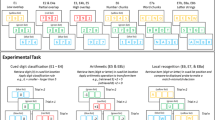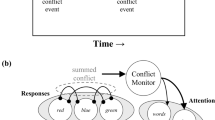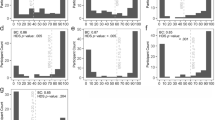Abstract
Experimental research in cognitive arithmetic frequently relies on participants’ self-reports to discriminate solutions based on direct memory retrieval from use of procedural strategies. Given concerns about the validity and reliability of strategy reports, Thevenot et al. in Mem Cogn 35:1344–1352, (2007) developed the operand-recognition paradigm as an objective measure of arithmetic strategies. Participants performed addition or number comparison on two sequentially presented operands followed by a speeded operand-recognition task. Recognition times increased with problem size following addition but not comparison. Thevenot et al. argued that the complexity of addition strategies increases with problem size. A corresponding increase in operand-recognition time occurs because, as problem size increases, working memory contains more numerical distracters. However, because addition is substantially more difficult than comparison, and difficulty increases with problem size for addition but not comparison, their findings could be due to difficulty-related task-switching costs. We repeated Thevenot et al. (Experiment 1) but added a control condition wherein participants performed a parity (odd or even) task instead of operand recognition. We replicated their findings for operand recognition but found robust, albeit smaller, effects of addition problem size on parity judgements. The results indicate that effects of strategy complexity in the operand-recognition paradigm are confounded with task-switching effects, which complicates its application as a precise measure of strategy complexity in arithmetic.



Similar content being viewed by others
Notes
An earlier experiment in our lab found no switch costs using a letter-comparison control task in which participants decided if a presented letter preceded or followed the letter E. This was a poor task-switch control, however, because the numerical task set (i.e., addition or number comparison) would not compete with letter comparison. In contrast, like operand recognition, parity judgments following addition or comparison required participants to switch number-processing task sets.
For the problem pair 7 5, Task 2 trials were always paired with a false comparison due to a coding error; this affected 0.01% of Task 2 trials and had no practical consequences for the recognition or parity tasks. Also, because false Task 2 addition answers were ±1 from the correct sum participants could use addition parity rules to solve Task 2 addition problems (Lemaire and Reder 1999). Future research might wish to avoid this possibility, but the current experiment was designed to be a close replication of Thevenot et al. (2007, Experiment 1) and adopted their rules for false answer stimuli.
We refer to the component stages of addition and comparison as Task 1 and Task 2, but because the Task 2 decision stage necessarily refers to the processes and representations generated during Task 1, it is reasonable to assume that they constitute an integrated task set and that task difficulty is properly indexed by total solution time (i.e., Task 1 + Task 2 RT).
As the parity task did not afford analysis in terms of first versus second operand we did not include this as a factor in our main analysis.
References
Allport, A., Styles, E. A., & Hsieh, S. (1994). Shifting intentional set: Exploring the dynamic control of tasks. In C. Umilta & M. Moscovitch (Eds.), Attention and performance (pp. 421–452). Cambridge, MA: MIT Press.
Arbuthnott, K. D. (2008). Asymmetric switch cost and backward inhibition: Carryover activation and inhibition in switching between tasks of unequal difficulty. Canadian Journal of Experimental Psychology, 62, 91–100.
Ashcraft, M. H. (1995). Cognitive psychology and simple arithmetic: A review and summary of new directions. Mathematical Cognition, 1, 3–34.
Campbell, J. I. D., & Metcalfe, A. W. S. (2008). Arabic digit naming speed: Task context and redundancy gain. Cognition, 107, 218–237.
Campbell, J. I. D., & Xue, Q. (2001). Cognitive arithmetic across cultures. Journal of Experimental Psychology: General, 130, 299–315.
Clapp, F. L. (1924). The number combinations: Their relative difficulty and the frequency of their appearance in textbooks. University of Wisconsin Bureau of Educational Research, Bulletin No. 2.
Cohen, L., & Dehaene, S. (1995). Number processing in pure alexia: The effect of hemispheric asymmetries and task demands. Neurocase, 1, 121–137.
Imbo, I., Vandierendonck, A., & Rosseel, Y. (2007). The influence of problem features and individual differences on strategic performance in simple arithmetic. Memory and Cognition., 35, 454–463.
Kirk, E. P., & Ashcraft, M. H. (2001). Telling stories: The perils and promise of using verbal reports to study math strategies. Journal of Experimental Psychology. Learning, Memory, and Cognition, 27, 157–175.
LeFevre, J.-A., Sadesky, G. S., & Bisanz, J. (1996). Selection of procedures in mental addition: Reassessing the problem size effect in adults. Journal of Experimental Psychology. Learning, Memory, and Cognition, 22, 216–230.
Lemaire, P., & Reder, L. (1999). What affects strategy selection in arithmetic? The example of parity and five effects on product verification. Memory and Cognition, 22, 364–382.
Monsell, S. (2003). Task switching. Trends in Cognitive Sciences, 7, 134–140.
Monsell, S., Sumner, P., & Waters, H. (2003). Task-set reconfiguration with predictable and unpredictable task switches. Memory and Cognition, 31, 327–342.
Monsell, S., Yeung, N., & Azuma, R. (2000). Reconfiguration of task-set: Is it easier to switch to the weaker task? Psychological Research, 63, 250–264.
Thevenot, C., Barrouillet, P., & Fayol, M. (2001). Algorithmic solution of arithmetic problems and operands–answer associations in LTM. Quarterly Journal of Experimental Psychology, 54A, 599–611.
Thevenot, C., Fanget, M., & Fayol, M. (2007). Retrieval or nonretrieval strategies in mental arithmetic? An operand recognition paradigm. Memory and Cognition, 35, 1344–1352.
Yeung, N., & Monsell, S. (2003). Switching between tasks of unequal familiarity: The role of stimulus-attribute and response-set selection. Journal of Experimental Psychology: Human Perception and Performance, 29, 455–489.
Zbrodoff, N. J., & Logan, G. D. (2005). What everyone finds: The problem size effect. In J. I. D. Campbell (Ed.), Handbook of mathematical cognition (pp. 331–346). New York: Psychology Press.
Acknowledgments
This research was supported by a grant and scholarship from the Natural Sciences and Engineering Research Council of Canada.
Author information
Authors and Affiliations
Corresponding author
Rights and permissions
About this article
Cite this article
Metcalfe, A.W.S., Campbell, J.I.D. Switch costs and the operand-recognition paradigm. Psychological Research 74, 491–498 (2010). https://doi.org/10.1007/s00426-009-0272-9
Received:
Accepted:
Published:
Issue Date:
DOI: https://doi.org/10.1007/s00426-009-0272-9




